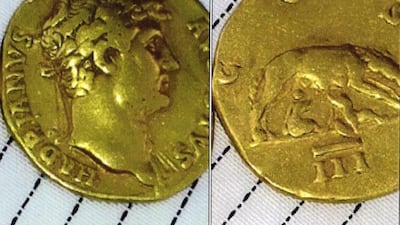WASHINGTON // The United States filed a lawsuit on Thursday to recover an ancient serpentine ring and gold coins trafficked by ISIL in a move aimed at preventing stolen Syrian and Iraqi antiquities from disappearing into collectors’ hands.
The US attorney filed a forfeiture claim in the US district court for the District of Columbia against the antiquities, thought to be worth hundreds of thousands of dirhams.
Officials have not said where the treasures might be, but the action aimed to warn would-be collectors that any purchase they might make could be contested.
The antiquities, including a neo-Assyrian stele — an ornamental slab often used for funerary or commemorative purposes — were identified from phone pictures and other electronic media seized from ISIL commander Abu Sayyaf, who was killed in a US raid in eastern Syria in May 2015.
Abu Sayyaf was in charge of raising money for ISIL from the antiquities trade, selling or taxing looted artefacts from the region, which is rich in cultural antiquities.
The group is believed to have raked in several million dollars from the lucrative trade, the US state department said last year.
US authorities recovered extensive records of the trade in the raid, including pictures, documentation of taxes collected and sales struck. There was even a claim by traders who said an ISIL official cheated them out of some valuable items.
Assistant US attorney Arvind Lal said the four items named in the seizure now the subject of the first court case of its kind were the first which could be clearly identified and described for legal action.
“When the raid was conducted on Abu Sayyaf, the United States collected a lot of electronic media, like mobile phones,” he said. “There were many, many images on that electronic media” of ancient artefacts.
In the lawsuit, the US formally lays claim to the items based on US sanctions against ISIL as a foreign terrorist group.
The aim, Mr Lal said, is to put the global antiquities trade on notice that anyone who buys them will not have legal title to them.
Mr Lal would not say if the US knows where the items are: a gold ring with a serpentine cameo face of the Greek goddess Tyche from 330-400 AD; second-century Roman coins featuring Antoninus Pius and emperor Hadrian Augustus Caesar; and a cuneiform stele possibly dating to the ninth century BC.
Mr Lal said the aim was not for the US to take permanent control of the items, but to return them to the authorities who are the rightful owners.
“Antiquities seized in the Abu Sayyaf raid were handed over to Iraq,” he said.
* Agence France-Presse

